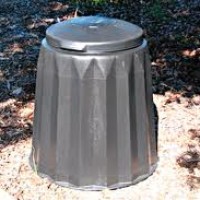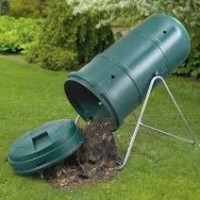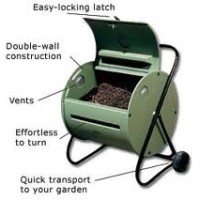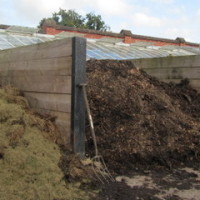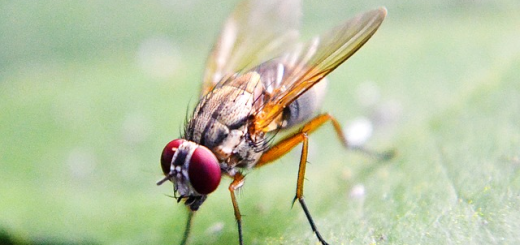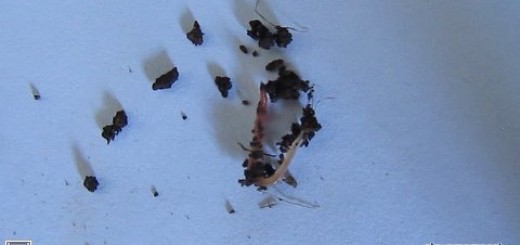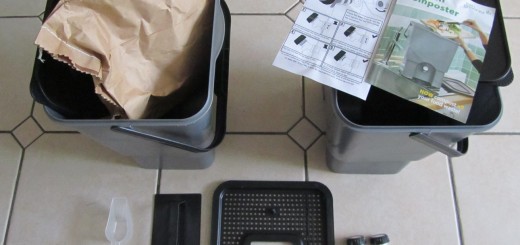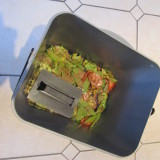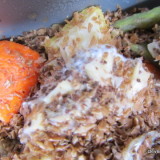On This Page
Intro
Using bins
Indoor Composting
Bokashi
Vermiculture (Worms)
Wrap-up
Intro
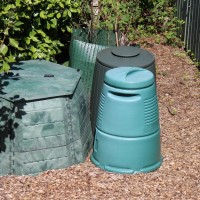 In the beginning, when you first decide you want to learn how to compost, you will need gain an understanding of the differences between compost systems. You will learn which are the most effective, how to set them up and, above all, which are most suitable for your circumstances. You may be inclined to just do the bare minimum of work or you may decide to go the whole nine yards and start off with a system that involves a lot of detail, equipment and a real investment in time and effort. This is one of the great bonuses when you take up composting. Whether you want to do this as a hobby, or as a cheap and simple way of dealing with your garden and household waste, you will discover how to compost in ways that will answer your requirements.
In the beginning, when you first decide you want to learn how to compost, you will need gain an understanding of the differences between compost systems. You will learn which are the most effective, how to set them up and, above all, which are most suitable for your circumstances. You may be inclined to just do the bare minimum of work or you may decide to go the whole nine yards and start off with a system that involves a lot of detail, equipment and a real investment in time and effort. This is one of the great bonuses when you take up composting. Whether you want to do this as a hobby, or as a cheap and simple way of dealing with your garden and household waste, you will discover how to compost in ways that will answer your requirements.
The space you have available, the volume of raw material to which you have access and the amount of time and energy you wish to invest in your project, are all considerations when first learning how to compost. You could well start with a basic heap in the corner of the garden and, as your enthusiasm grows, you could find your pile developing into something more elaborate and time-consuming. You will need to understand something about composting methods, the difference between HOT and COLD composting, for example. You will want to know the differences between BATCH and CONTINUOUS composting, what each entails and achieves and which compost systems employ which methods.
How to Compost using Bins – there are 3 ways
- A single holding unit
- A two or three-bin static system
- A rotating, or tumbling compost bin
- A holding bin for back yard composting
- Static turning bins from breeze-blocks
- A Vertical Tumbler
Holding Units are containers where the raw materials are just held until the composting process is complete. The commonly used plastic ‘dalek’ bins are holding units and are good to start off with when first learning how to compost. These are often on a special offer that has been negotiated by your local council (UK) and are well worth using while you get yourself together.
A single unit like this lends itself well to DIY, however and you can utilise all sorts of items to make a cost-free container. Pallets, spring to mind, as do breeze-blocks, bales of hay, and a variety of wooden options. If you use one of the available dalek bins as a Holding Unit, you will likely find it difficult to attain the temperatures needed to do Hot Composting. This will partly be because you will probably be feeding the materials in on a continual basis and partly because of the lack of mass and the poor insulating properties of plastic. So, Cold Composting or with luck ‘Warm’ Composting will be the result.
Turning Units are those compost bins where the ingredients are turned regularly in order to add oxygen to the pile. This builds up the heat which accelerates the composting process and, if the temperatures reached are high enough, sterilizes the finished product.
(It is worth noting, however, that Hot Composting can occur in a single unit without heaps of labour if the pile has a big enough mass and if the ingredients are right. Visit stables, even on a cold winter’s day and see the steam rising from the huge pile of straw bedding mixed with manure that is the result of ‘mucking out’ the stalls. Wow!)
Turning Units come in two types:
- revolving bins and tumblers in which the compost is turned by some mechanical means
- 2 0r 3-bin systems which are ‘static’ where the turning of the compost is done manually with forks and spades.
- A Compost Tumbler
- A Horizontal Compost Tumbler
- Steaming away nicely!
The Tumbling or Rotating bins (similar thing, different names) mean that you do not have to carry out what may seem to be arduous hours tossing your ingredients around in order to keep it aerated. Of course, others may see that as an opportunity to keep fit and to spend legitimate ‘thinking time’ away from the stresses of everyday existence!
Static Turning Units are what we call 2 or 3 bins ranged side-by-side. The compost is turned regularly with a pitchfork and at the right time, is turned from the first bin into the second bin to complete maturation. This allows for the first bin to be re-filled and the process started over. When ready, the contents of the second bin are turned into the third bin for storage until needed.
This takes up a fair bit of room and you need loads of raw materials and to have a use for the finished product. I most often see this system in use in large estates which are open to the public and on farms and small-holdings.
Indoor Composting – How to Compost in an Apartment
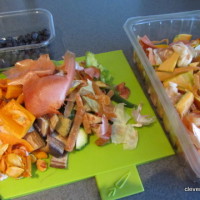
Waste for the Bokashi Bin
Right now, more and more people than ever before are wanting to learn how to compost and fewer and fewer are the owners of large gardens with heaps of space. Apartment dwellers, whose growing space consists of a small balcony or a potted plant still have organic waste to dispose of, however, so here is something for them. Three ways of indoor composting that are easy to accommodate in a relatively small space.
- Bokashi
- Vermiculture (worm farming)
- Indoor compost bins
As well as being suitable for indoor composting, these are systems that operate in special environments and they have the added benefits of being able to handle materials that are difficult to deal with when using regular means. Meat and dairy products which cannot usually be dealt with in an out door composting environment can be dealt with using Bokashi for example. This makes indoor composting a truly viable option and properly utilised, gives apartment dwellers an opportunity to deal with virtually all their organic waste ‘in-house.’ No longer is a large outdoor space necessary for composting to take place. ‘Indoor composting is the new outdoor composting!’
How to Compost Using Bokashi
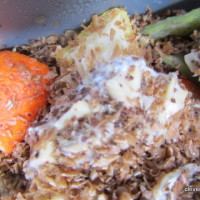
White mould. Part of the process.
Bokashi, which has its origins in the East, is an anaerobic system which pickles kitchen scraps and it is great for indoor composting. (Regular decomposition occurs through the action of aerobic bacteria.) Bokashi is especially good for all types of food waste, including cooked food, meat and dairy. (The latter items are difficult to dispose of in a garden bin.) The essential microbes (known as EM) which do the work, are held in a bran mix which is sprinkled over waste when it is placed in the bin and that is it – once again, deceptively simple. I have 2 Bokashi bins in my kitchen that I work in tandem. They are, to all intents and purposes, odourless and really easy to manage. I put the resulting pickled materials into my out-door compost bins where it accelerates the activity there and adds to the potency of the finished product. That mix will eventually be used in my small urban patch. To learn more about how to compost with Bokashi, click here.
Vermiculture, a.k.a. composting with worms
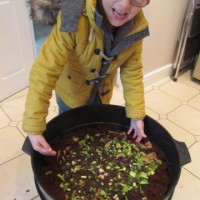
Adding some food for our new tenants.
I don’t know about filing this under ‘indoor composting’ but in fact many people do keep their worm farms under cover, maybe in a basement or garage and even in the kitchen. Not for me, but composting with worms is excellent for dealing with vegetable matter both on a small scale in a domestic environment and in commercial enterprises. Composting with worms is a great hobby and many people make a living out of it, raising these small creatures for fishing bait, with the compost as a side-line. Worms are also used for the commercial composting of food waste in hospitals and schools which is a huge thing in many countries.
As with all composting, you can set up a system that is cheap and does a good job, or you can purchase manufactured compost bins that are a bit more pricey. DIY buffs often use old baths, metal drums, plastic boxes – you name it. If you can drill a hole in it, you have a starter. Commercially produced bins do have some advantages though, apart from being better to look at.
The needs of worms are few but specific. They need food, moisture, darkness and a reasonable temperature. Setting up your farm with bedding and food is a surprisingly satisfying experience and composting with worms offers a grand opportunity to introduce children to the practice of re-cycling as well as giving practical experience in looking after animals, something that is becoming increasingly popular in schools around the world.
The icing on the cake is that the end product of composting with worms (worm casts) is the best quality compost there is.
Wrap-up
This is just an introduction to how to compost at home. These are the ways you will read most about when you are learning how to compost. Some you will find are suitable for indoor composting, while others are better suited to large gardens. Some are easier for those with physical limitations (dodgy backs, for instance) while others should be avoided if you have neighbours that are in close proximity and who may be offended by the site of an unruly compost pile.
As you learn how to compost, pick and choose the techniques and methods that will work for you. If you are happy with what you are doing, you will stay with it longer and achieve success.
‘How to compost.’ The answer is deceptively simple. On the face of it, it is one of the most basic procedures on earth. It happens all the time, everywhere, to everything that ever lived. It is, quite simply, decay. Scientists revealed its complexity when they unravelled the microscopic action that occurs in a compost heap. Further complexity is added when we come along and ‘manage’ it for our own ends. It is a wonderful thing, composting. Each person sees in it what he or she chooses and that is that.

